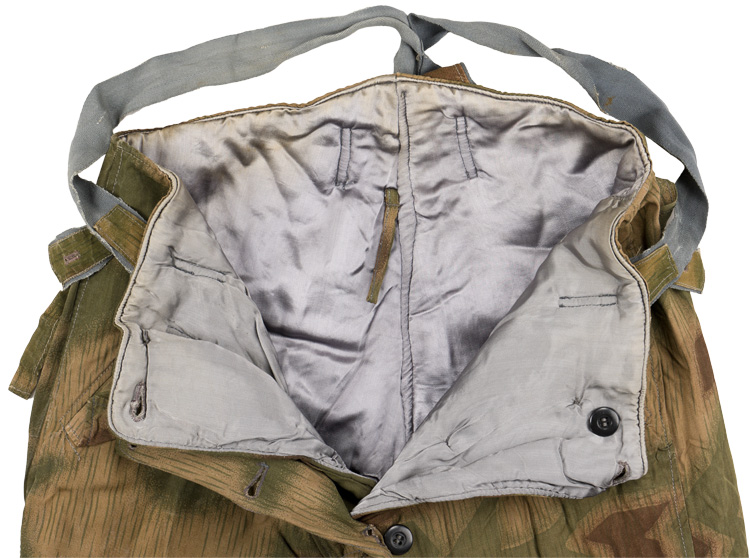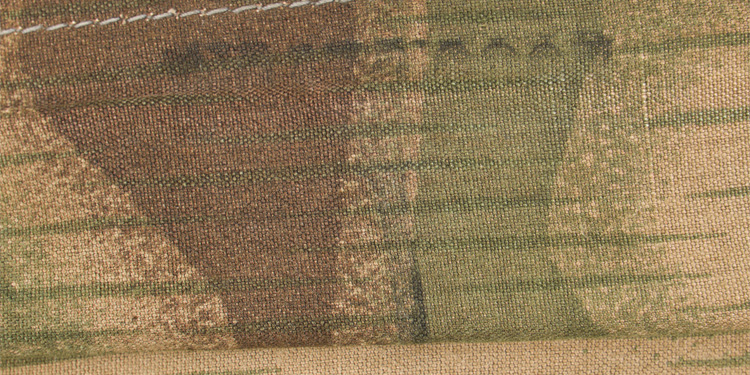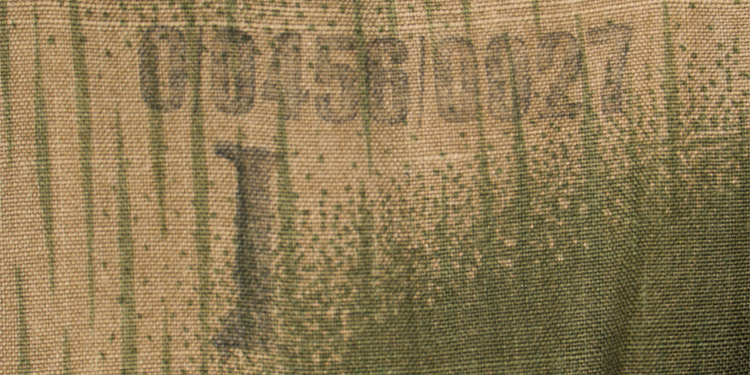







H039788 TAN/WATER PATTERN CAMOUFLAGE, NON-REVERSIBLE, WINTER SUIT. (Tarnanzug)
BACKGROUND: The development of camouflage clothing and equipment had began in the German Army in WWI, and continued through the Weimar Reichswehr, (National Defence Force, Circa 1919-1933), era. The German army’s geometric, Splittertarnmuster 31, (Splinter camouflage pattern 31), was originally developed in late 1929 and early 1930 and was first adopted for use with the M31 quarter shelter/poncho in late 1931. Further developments in 1943 modified the original splinter pattern by softly blurring the distinct geometric pattern and slightly altering the coloration. This modified camouflage pattern was designated Sumpftarnmuster, (Swamp/Marsh camouflage pattern), although it is now commonly referred to as the Tan/Water camouflage pattern, which was once again altered in 1944 by an even stronger blurring of the distinct geometric pattern. Further camouflage pattern development continued through-out the war and additional subtly different patterns were created with the intent to equip all personnel with the same camouflage pattern but this was never achieved. After the devastating winter of 1941-1942 on the Russian front the German Army found that it was drastically under equipped with cold weather garments to withstand the severe cold and a wide variety of improvised garments including a broad assortment of donated civilian garments were utilized as a temporary solution. To rectify the situation the OKH, Oberkommando des Heeres, (High Command of the Army), began testing heavier winter clothing in the spring of 1942 to develop suitable garments for the Russian front. In April 1942 Hitler approved the chosen designs and the first models were issued in the autumn of that year, in the reversible blue/mouse grey/white colorations, which was modified to camouflage pattern/white combinations in 1943. Included with these new garments were heavy, padded, reversible winter suits which consisted of a parka, pants and separate hoods and mittens. Of Note: These garments were also produced in non-reversible models. The winter suits were a standard issue item and were distributed to all EM/NCO’s for the winter season, (September 15TH to April 15TH), with other winter garments and were to be returned to the units clothing depot in April for storage, repair and cleaning to be reissued the following September. Originally Officers and senior NCO’s responsible for purchasing their own uniforms and headgear were required to purchase the new winter garments until regulations of December 1942 extended the issue winter clothing to all ranks in the colder theatres of operation. Although the reversible suits proved quite effective they were very difficult to keep clean and launder which resulted in regulations dictating that the white side was only to be worn on the exterior when absolutely necessary. This example consists of the non-reversible parka and pants.
PHYSICAL DESCRIPTION: The three quarter length, water repellant, cotton/rayon blend construction, non-reversible, double breasted style parka features the machine roller printed, geometric, Swamp/Marsh-Tan/Water camouflage pattern in shades of tan, brown and green with small, repeating, green "rain-drops" to the exterior and a grey rayon lined interior. The parka features a large, overlapping, vertical, six button front closure with a smaller, overlapping, exterior, wind flap. The parka has two, slightly, diagonally angled, slash hip pockets with straight edged, button down flaps, positioned at either side of the front closure, at the waistline. The straight cut, dual-ply, sleeve cuffs each have a machine stitched, horizontal, tunnel loop with an inserted, horizontally extend, white and grey/green fabric, fit adjustment draw strap with a single button eyelet and dual corresponding fit adjustment buttons to each cuff. The sleeves each have a large, dual-ply, rectangular reinforcement panel to each elbow and molded black bakelite buttons to both the inner and outer, upper sleeve seams, which were designed for wear of the identification armbands by front line troops. The parka has a single-ply, unpadded, integral hood, which is large enough to accommodate a helmet. The forward edge of the hood has four, small, evenly spaced, tapering darts and a machine stitched, tunnel loop with an inserted, twisted, white cotton fit adjustment drawstring intact. The interior of the parka is fully lined, excluding the hood, but including the sleeves, in grey rayon with an ersatz, internal, heat retaining, padding through-out. The interior of the parka has a machine stitched, horizontal, tunnel loop positioned at the waistline, with a small, vertical, slash positioned at either side of the front closure, with dual, inserted, horizontally extend, white and grey/green fabric, fit adjustment draw straps to each. The interior, bottom edge of the tail skirt also has a machine stitched, horizontal, tunnel loop, with an inserted, twisted, white cotton fit adjustment drawstring intact. All original buttons and stitching. Nicely Rbnr# marked. Roughly a size 40" chest. Comes with a perfectly matched set of trousers which are also size "I" and Rbnr# marked. Beautiful matched set!
GRADE
****1/2
PRICE $ ![]()
To Order this item, please use one of the two e-mail addresses below to contact us. Please make sure to quote the item number in your e-mail
MILITARIA WANTED! If you have items for sale, please contact us. We specialize in selling single pieces and entire collections. Over 3 decades in the business and we do all the work for you. Get the best return for your investment.
-E-Mail Address pawmac@nbnet.nb.ca Or guild@nb.aibn.com
To return to the main page please CLICK below